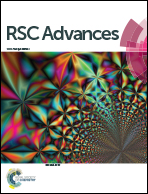3D nano-macroporous structured TiO2-foam glass as an efficient photocatalyst for organic pollutant treatment†
Abstract
This work reports the preparation of 3D nano-macroporous structured TiO2-foam glass (p-TiO2/FG) as an efficient photocatalyst for the degradation of organic pollutants in water. Nanoporous TiO2 film was coated on macroporous foam glass by using a simple sol–gel coating method. In this work, we used waste glass to prepare foam glass with suitable apparent density (0.98 g cm−3) and high open porosity, which facilitated direct light absorption by the TiO2 film. Especially, the foam glass had a high adsorption capability for methylene blue (MB), which increased the quantity of organic pollutant to come in contact with TiO2 through means of adsorption and hence improved the photo-degradation efficiency. The p-TiO2/FG exhibited much higher photocatalytic activity than that of the TiO2/FG without a 3D nano-macroporous structure, which was attributed to the increase of reaction sites on p-TiO2/FG generated from its special 3D nano-macroporous structure. Additionally, the p-TiO2/FG presented high stability and recyclability, retaining high photocatalytic activity even after 10 cycles, which was mainly attributed to the uniform and stable coating of TiO2 film on the foam glass.


 Please wait while we load your content...
Please wait while we load your content...